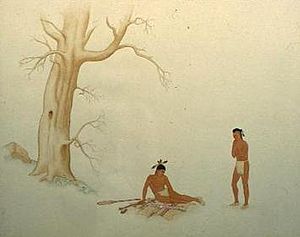Sanford Plummer facts for kids
Sanford Plummer (whose Seneca name was Ga-yo-gwa-doke) was a talented Native American artist. He lived from 1905 to 1974. Sanford Plummer was a member of the Seneca Nation and was known for his watercolor paintings. His art often showed the traditional life and culture of the Seneca people and other Iroquois nations. You can see his work in museums like the Iroquois Indian Museum, the Buffalo Museum of Science, the Rochester Museum and Science Center, and the Newark Museum.
Contents
Early Life and Education
Sanford Plummer was born on November 1, 1905. His birthplace was the Allegany Reservation in New York. This area is mostly in Cattaraugus, New York. His parents were Clarence Plummer and Nellie Kennedy.
The Seneca people, like other Iroquois nations, have a special family system. Children are part of their mother's family group, called a clan. Sanford Plummer was born into the Seneca Wolf Clan because of his mother's family line.
He traveled to New York City to study art. He attended the Beaux-Arts of New York and the New York Academy of Art. After finishing his studies, Plummer moved back to upstate New York. He lived in a town called Gowanda.
His Art and Style
Sanford Plummer was very good at telling stories through his art. He painted scenes from traditional Iroquois life and ceremonies. He also showed important parts of their oral history. An example is his painting Law, the Reading of the Wampum.
Most of Plummer's paintings have simple backgrounds. This helps you focus on the people in his artwork. Every detail in his paintings had a special meaning. Some of his works, like a portrait of Seneca chief Red Jacket, have very detailed backgrounds. His art style was similar to the Iroquois Realist School from the 1800s.
Art and Community Programs
In the 1930s, Sanford Plummer took part in a special government program. It was part of the New Deal, which helped people during tough times. This program, called the Temporary Emergency Relief Administration (TERA), paid artists on New York's Native American reservations. They created traditional art.
By 1934, the TERA program helped place Native art in museum collections. Another artist in the program was Jesse Cornplanter, a Seneca woodcarver. The program even created a temporary museum at the Thomas Indian School. Arthur C. Parker, a Seneca anthropologist, led this program in New York. He is thought to have helped Plummer's art career a lot.
In 1940, Pennsylvania Governor Arthur H. James was welcomed into the Seneca Nation. Sanford Plummer created a special scroll for this event. He painted a Seneca man greeting a European-American man. The scroll also had writing in the Seneca language.
Legacy and Collections
Sanford Plummer passed away in Gowanda, New York, in June 1974.
The Newark Museum has a large collection of his works. These include watercolor paintings, pencil drawings, and even a design for a book cover. IBM donated this collection to the museum in 1962. The Rochester Museum and Science Center and the Buffalo Museum of Science also have his paintings.


